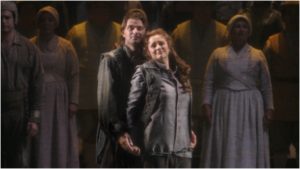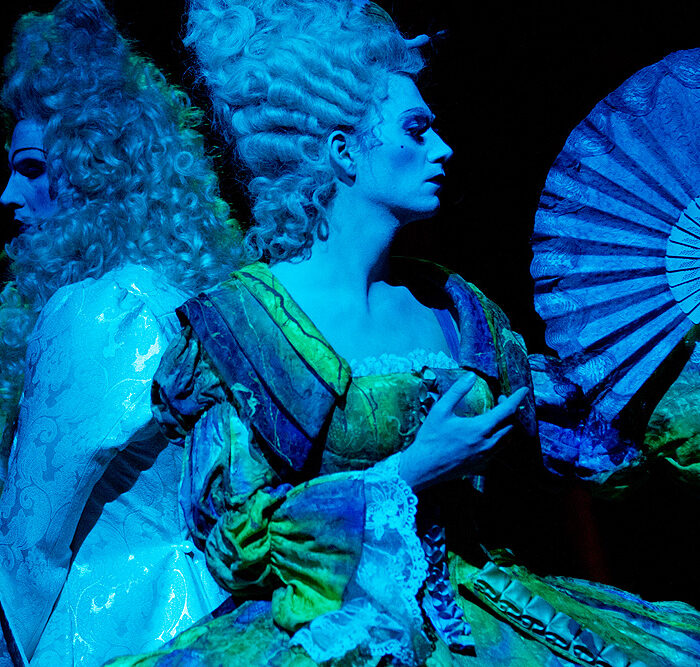
Opera Profile: Beethoven’s “Fidelio”
By Logan Martell“Fidelio” first premiered on Nov. 20, 1805 and is the only opera composed by Ludwig Van Beethoven. While he was originally working with librettist Emanuel Schikaneder, who wrote “The Magic Flute,” difficulties with the composition, as well as the annulment of their contract, freed up Beethoven to work with Joseph Sonnleithner on what would become “Fidelio.”
While it remains a point of speculation as to why a composer such as Beethoven only produced one opera in his lifetime, some have attributed it to the decline of his hearing, or to a personal connection to the theme of faithful love set within religious allegory. What remains certain is that despite a rather poor opening and after a number of revisions, “Fidelio” has become a cherished member of the operatic canon.
Short Plot Summary
The opera opens in a Spanish prison located near Seville, with a duet between Jacquino and his unrequited love Marzelline, daughter of the jailer, Rocco. Marzelline rebukes him as she is in love with Fidelio, an assistant to Rocco alongside Jacquino. Unbeknownst to her, Fidelio is actually a woman named Leonore who has infiltrated the prison so that she may free her husband Florestan, a nobleman wrongfully arrested for threatening to expose the crimes of the prison’s governor, Don Pizarro. As Fidelio gains the trust of Rocco, he confides in her his desire to marry Marzelline to Fidelio, and the knowledge of Florestan, kept deep within the dungeons where he allows none of his assistants. Shortly after, Don Pizarro enters; Rocco warns him of the upcoming inspection by Don Fernando, minister of the king, due to rumors of Pizarro’s cruelty. Pizarro resolves to finally kill Florestan, lest he risk Fernando discovering the missing nobleman whom Pizarro declared dead to the world. While Rocco refuses Pizarro’s payment to murder Florestan, he agrees to prepare his grave within a ruined well and give the signal when all is ready for Pizarro to commit the murder.
Initially furious with Rocco and Pizarro, Fidelio quickly hatches a plot to free her husband. Using Marzelline’s love for Fidelio, they convince Rocco to temporarily release the prisoners so they may enjoy the weather outside while Rocco keeps Pizarro busy. Rocco, however, returns shortly with the news that Pizarro will allow for a marriage between Fidelio and Marzelline, and permit for Fidelio to assist Rocco in the dungeons below. Before they can enter the dungeons, Jacquino and Marzelline warn them of the coming Pizarro, furious after discovering the released prisoners. The act ends with Fidelio’s initial plan thwarted, and the prisoners despondently being returned to their cells, both cases of freedom denied.
Within his cell in the dungeon, Florestan sings of his faith in God before experiencing a vision of his wife coming to his rescue. Rocco and Fidelio arrive then to dig Florestan’s grave, despite Fidelio stalling for time. Florestan awakes and begs Rocco to deliver a message to his beloved Leonore; while Rocco denies him the message he allows him to have a drop of water and a crust of bread. When the grave is readied, Rocco sounds the alarm to give Pizarro the signal before sending Fidelio away. Hiding herself, Fidelio watches as Pizarro enters and taunts Florestan for the last time. As he raises a dagger to deliver the killing blow, Fidelio leaps between them, reveals her identity, and draws a gun on Pizarro, locking them in a heated standoff. Before either can make a move, the sound of a trumpet announces the arrival of Don Fernando, who quickly sets things right when he recognizes the missing nobleman. Don Pizarro is arrested and Leonore has the privilege of unlocking the chains which bind her husband before they are blissfully reunited. A chorus sings praise for the faithfulness demonstrated by Leonore as the opera is brought to a close.
Famous Musical Numbers
The overture of “Fidelio” has seen several revisions. While the overture titled “Leonore No. 3” is regarded as the most famous of the four iterations, many have noted that the dramatic power it expresses does not transition well into the beginning scenes of the opera. “Leonore No.3” then, is often played between the two scenes of the second act while the opera is opened with the fourth revision simply referred to as the “Fidelio overture.”
The quartet in Act one, “Mir ist so wunderbar” is noted for how well it conveys the intentions of each character as they sing in an elegantly-constructed canon. While Leonore, Rocco, Marzelline, and Jacquino are all experiencing disparate emotions, the expression of their inner worlds do not conflict with one another, but rather serve to highlight their beauty and display the unity of their intertwined predicaments within the prison.
Act two opens with Florestan’s aria “Gott! Welch Dunkel hier!” Having been a missing but crucial component of the plot until this point, here the audience bears witness to the darkness the nobleman has been plunged into, accentuated by broken melodic lines and the use of pained tritones. The first words were left without dynamic markers and so it remains for the performer how to interpret them and demonstrate either brokenness of spirit, defiance of circumstance, or unremitting faith in the possibility of rescue.
Also worthy of note is the famed chorus in the first act, as well as the famed finale, an ode to fidelity that features some of Beethoven’s most awe-inspiring music.
Watch and Listen
Here is a rather unique version from Salzburg 2015 which stars Jonas Kaufmann as Florestan, a role that he has dominated over the last decade.
Categories
Opera Wiki

